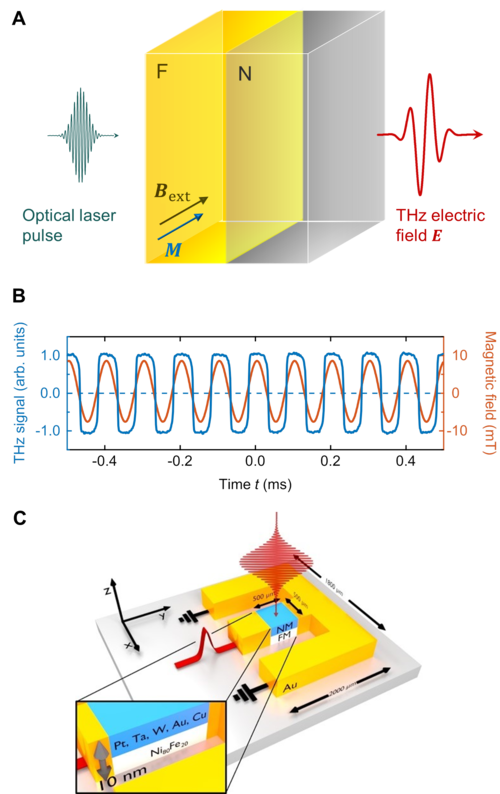New functionalities of spintronic terahertz emitters: rapid polarization control and on-chip integration
TRR227 scientists publish latest results on spintronic terahertz emitters in Optica and ACS Appl. Nano Mater.
News from Aug 23, 2021
Spintronic terahertz (THz) emitters (STEs) are a novel class of broadband, low-cost and efficient THz sources. They exhibit interesting opportunities for applications in the fields of THz physics and THz photonics, where THz electromagnetic pulses are used for material characterization, imaging and spectroscopy. Consequently, STEs are meanwhile commercially available from the Berlin-based startup TeraSpinTec GmbH.
To trigger the emission of ultrashort THz electromagnetic pulses, an STE is driven by femtosecond laser pulses (Figure A). STEs have unique properties: First, the polarization (i.e. the alignment) of the THz electric fieldis always perpendicular to the magnetization M of the STE, which, in turn, is straightforwardly controlled by the external magnetic field Bext. Second, because they are made of extremely thin metal layers, STEs can easily be shaped for integration into nano-structures (Figure C). Very recently, research groups from Berlin and Halle took advantage of these properties in the framework of the Collaborative Research Center 227 and jointly demonstrated two new functionalities of STEs.
“First, to modulate the direction of the THz electric field at very kilohertz rates, we developed a fast electromagnet. It generates a magnetic field that oscillates or rotates with frequencies up to 10 kHz.”, explains Oliver Gueckstock of Freie Universität Berlin. A modulation contrast of more than 99% was achieved over a bandwidth of 1-30 THz (see Figure B). The results are highly relevant for various THz spectroscopic applications, for example low-noise THz-field detection and material probing. “We are confident that we will soon push the modulation frequency to 100 kHz and beyond.”, concludes Oliver Gueckstock.
“Second, we used lithography to integrate STEs into micrometer-sized waveguides on a chip.”, says Wolfgang Hoppe of Martin Luther University Halle. Following femtosecond laser excitation of the STE, the resulting THz voltage pulses were launched into a waveguide (Fig. 1c). This approach has intriguing features: The generated THz voltage pulses exhibit unipolar shape, which contains all frequencies from the THz range down to 0 Hz. Wolfgang Hoppe concludes: “The on-chip approach will allows us to confine the THz field in very small volumes. It offers a route to large THz field strengths and the THz probing of small sample volumes in a lab-on-a-chip.
Figure description: (A) An STE consists of a magnetic layer (F) and nonmagnetic layers (N). A femtosecond laser pulse leads to the generation of a THz electric field directly behind the F|N stack. Note that is perpendicular to the magnetization, which is set by the external magnetic field. (B) Measured modulation of the polarity of the THz-pulse peak field at ~10 kHz. (C) On-chip integration of an STE. Picture taken from ACS Appl. Nano Mater. 4, 7454-7460 (2021).
Original publications:
O. Gueckstock, L. Nadvorník, T.S. Seifert, M. Borchert, G. Jakob, G. Schmidt, G. Woltersdorf, M. Kläui, M. Wolf, T. Kampfrath
Modulating the polarization of broadband terahertz pulses from a spintronic emitter at rates up to 10 kHz
Optica 8, 1013-1019 (2021)
W. Hoppe, J. Weber, S. Tirpanci, O. Gueckstock, T. Kampfrath, G. Woltersdorf
On-Chip Generation of Ultrafast Current Pulses by Nanolayered Spintronic Terahertz Emitters
ACS Appl. Nano Mater. 4, 7454-7460 (2021)

